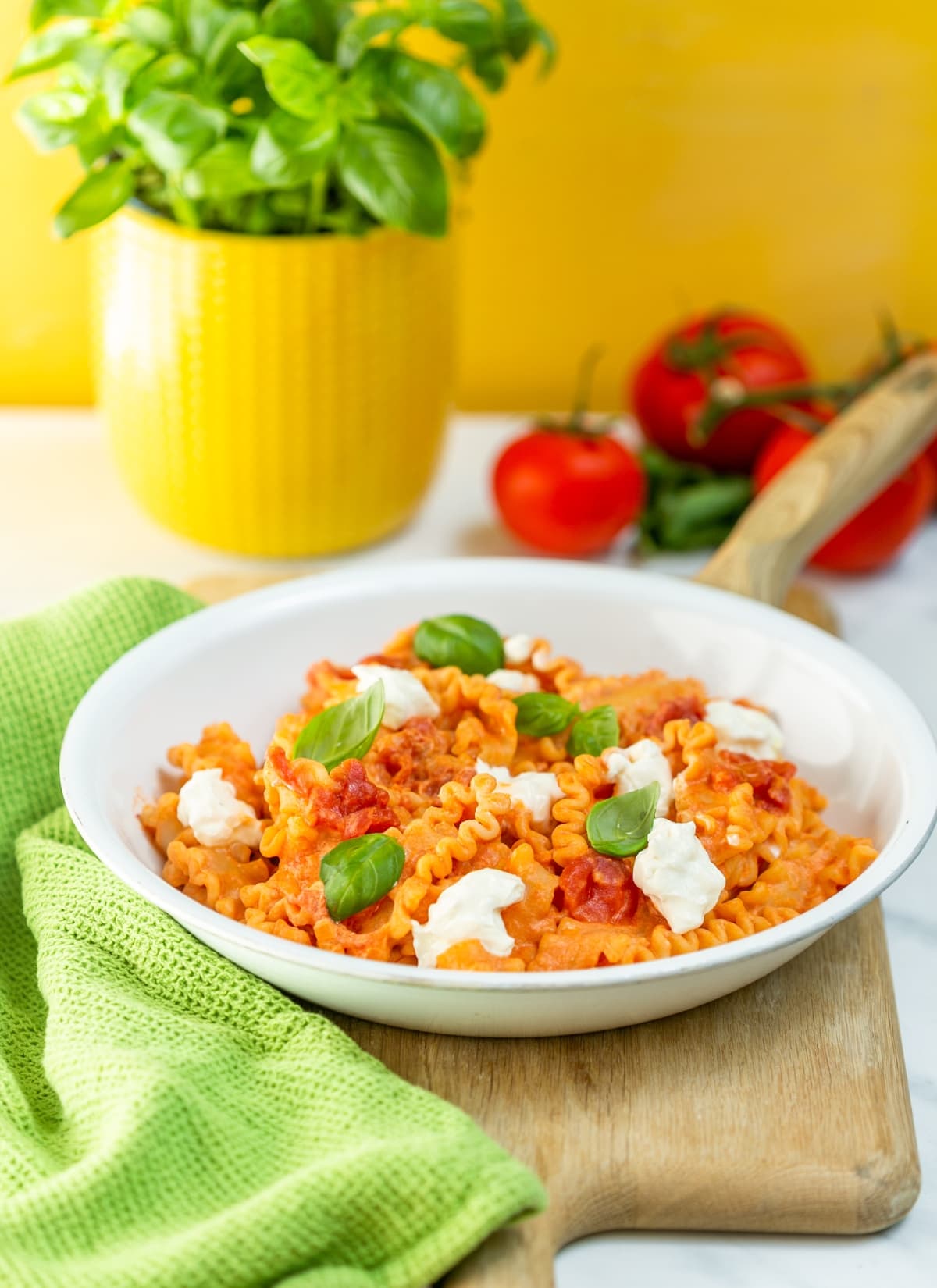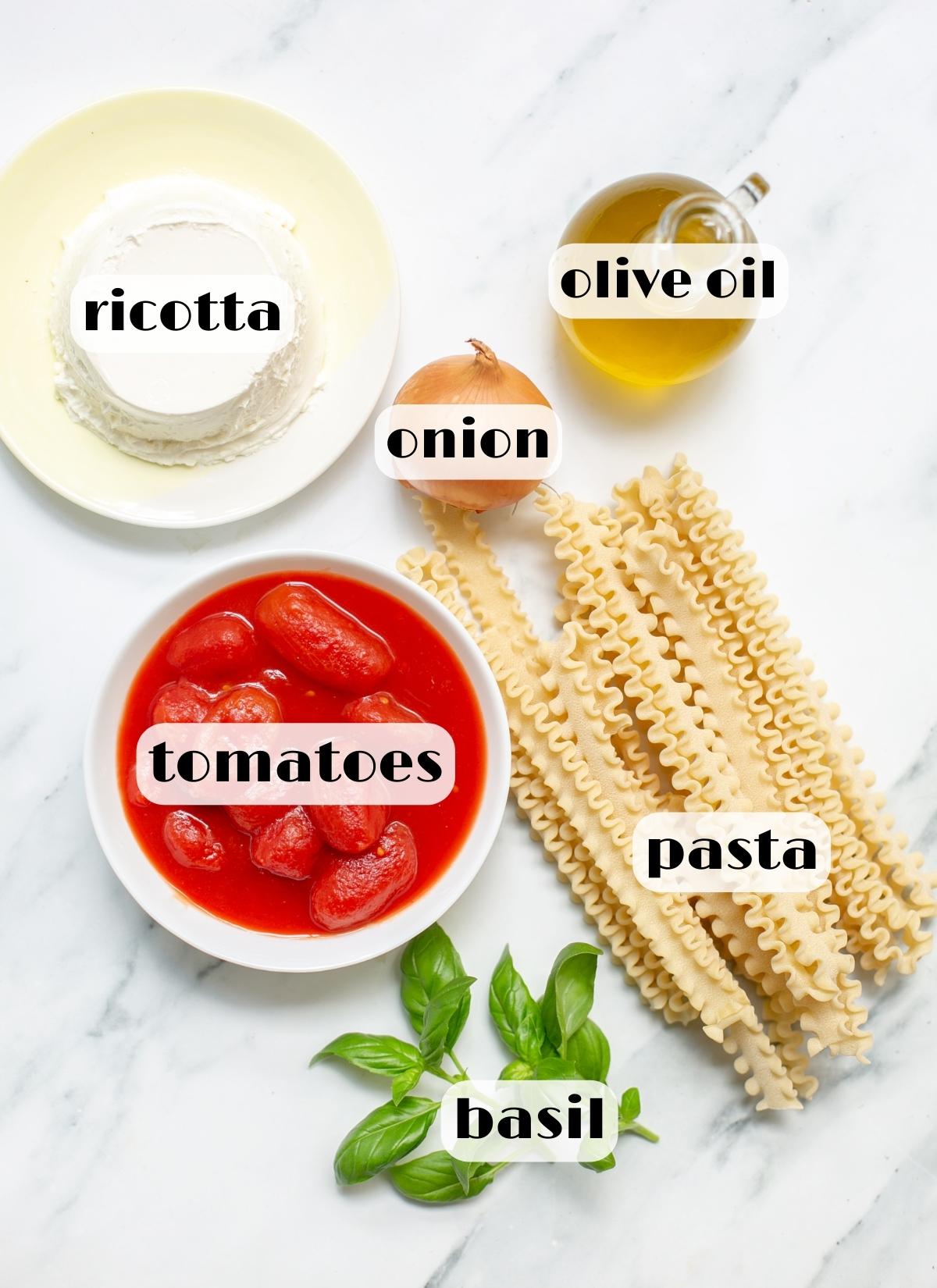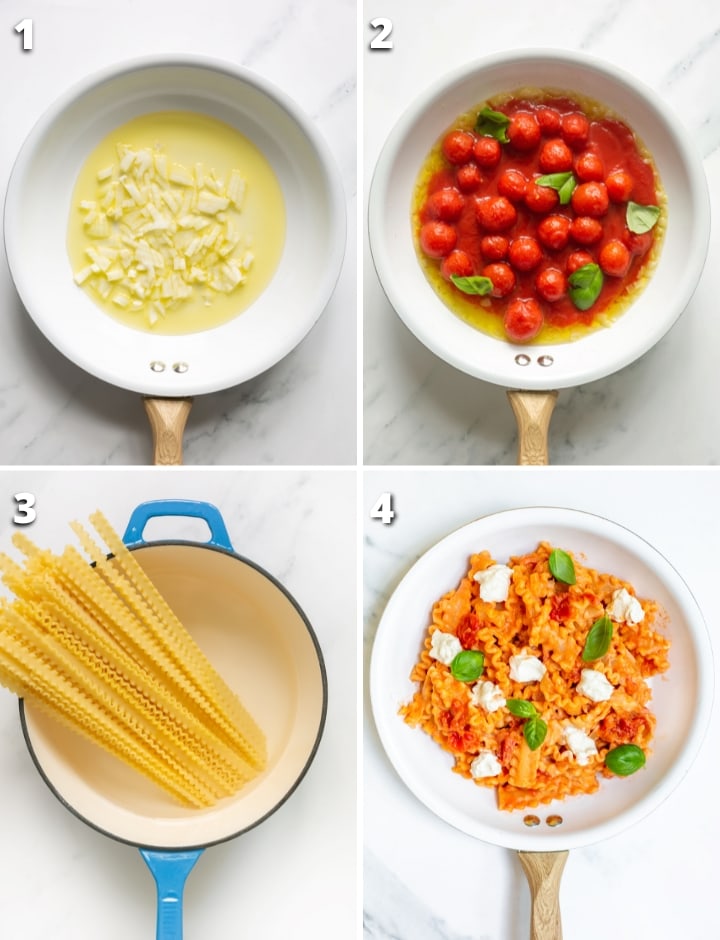Dinner ready in 20 minutes with this quick mafaldine pasta with Napoletana sauce - Learn all the tips to make this traditional mafalde pasta recipe!
Mafaldine pasta with tomato and ricotta cheese is a delicious traditional pasta dish from Naples.
This dish is traditionally prepared during holidays in Naples, or simply for Sunday lunch.
The uniqueness of this dish lies in the pasta used, which is the mafalda pasta, also known as mafalde, mafaldine or reginette.
Mafalda noodles are similar to lasagnette and have curled edges, making them a perfect match for the traditional Napoletana sauce, which is made with ricotta cheese and tomato sauce.
It takes just 20 minutes to make, and it calls for the most simple ingredients such as tomatoes, onion, pasta, ricotta, extra-virgin olive oil, and fresh basil.

So if you're looking for a classic quick pasta sauce look no further than this authentic mafalda pasta recipe!
Perfect for entertaining or for a quick weeknight dinner, it's sure to please both kids and grown-ups!
Jump to:
What is Mafalda Pasta?
Mafalda pasta, also known as mafalde, mafaldine, reginette or manfredi, is a type of ribbon-shaped pasta very popular in Naples and the Campania region.
Its long, wide and flat shape is similar to tagliatelle or pappardelle, but with curly edges that conveniently scoop up the sauce.
Mafalde is often served with ragu' or with tomato sauce and ricotta cheese.

Mafalda Pasta Recipe Ingredients
This mafalde pasta with napoletana sauce is incredibly simple and calls for super basic ingredients.
To make the most of it, pick the best-quality ingredients you can!
Here's what you need to make this traditional mafaldine pasta recipe:

- Pasta: I use mafalda pasta, but spaghetti, penne, rigatoni, bucatini and fusilli all work well too.
- Tomatoes: I used Italian canned datterini tomatoes. Canned San Marzano tomatoes or cherry tomatoes are also perfect options. When they're in season, you can use fresh tomatoes too, here's how to make tomato sauce with fresh tomatoes.
- Ricotta: Fresh homemade ricotta or high-quality store-bought ricotta cheese. If you can find it, use buffalo ricotta cheese, it tastes incredible.
- Onion: Adds sweetness to the sauce, you can replace it with a garlic clove or use both.
- Extra-virgin olive oil: Always use high-quality olive oil, which adds sucha deep and amazing flavor to the sauce.
- Basil: Fresh basil is a key ingredient, don't replace them with dried basil.
Additional ingredients:
This simple recipe is incredibly tasty and flavorful as it is, but if you like, you can add some extra ingredients:
- Black or green olives: pitted olives add a nice layer of flavor.
- Red pepper flakes: add a spicy kick to your pomodoro sauce with a pinch of red pepper flakes.
How To Make Mafaldine Pasta with Napoletana Sauce
The beauty of this simple and quick mafaldine pasta recipe is that it's ready in just 20 minutes, and it's super easy to make.
Here below is the step-by-step recipe with pictures.
Scroll down until the end of the post for the full printable recipe.

STEP 1. Heat the olive oil and onion in a skillet over medium-low heat.
STEP 2. Add the tomatoes and crush them with a wooden spoon. Add basil leaves, cover with a lid, and cook for 15 minutes.
Cooking tip: I like to cut the tomatoes in half and remove the seeds before use. Tomato seeds might add bitterness to the sauce.
STEP 3. In a large pot of lightly salted boiling water add the mafalda pasta and cook according to the package directions. For al dente pasta, drain it 2-3 minutes before the suggested cooking time.
STEP 4. Mix the pasta with the tomato sauce, mix in the ricotta, drizzle with additional olive oil, and serve.

Storage Tips
Store leftover mafaldine with napoletana sauce in an airtight container and refrigerate for up to 1 day.
Recipe FAQs
Fresh tomatoes have a lower acid than canned tomatoes, so if you use the latter and the tomato sauce is a bit acidic, simply add a bay leaf whilst it cooks, or a pinch of sugar.
More Italian Dinner Recipes To Try
- Traditional Italian Pasta e Fagioli
- Pollo alla Cacciatora (Chicken Cacciatore)
- Ricotta Meatballs - Italian Recipe
- Pumpkin Risotto
- Traditional Bolognese Sauce- Beef Ragu'
- Polpette - Italian Meatballs
- Chicken Pizzaiola
- Steak Pizzaiola - Carne alla Pizzaiola
- Authentic Italian Potato Frittata
- Ossobuco alla Milanese
Did You Try This Recipe?
Please let me know how you liked it! Leave a comment below and share a picture on Instagram with the hashtag #thepetitecook!
Don't forget to subscribe to my newsletter and follow along on Facebook, Pinterest and Instagram for all of the latest updates.
Recipe
Mafaldine Pasta with Napoletana Sauce
Ingredients
- 1 medium-large onion, finely minced
- 2 cans organic whole plum tomatoes (15oz/400gr each) , or canned datterini tomatoes
- 2 tablespoon extra-virgin olive oil
- 8 fresh basil leaves
- sea salt and black pepper to taste
- 17.06 oz mafalda pasta
- 8.8 oz ricotta cheese, approx 1 US cup
Instructions
- Heat the olive oil and onion in a skillet over medium-low heat, and cook until the onion is translucent, about 4-5 minutes.
- Add the tomatoes and their juice and crush them gently with a wooden spoon. Season with 6 basil leaves, cover with a lid, and cook on low heat for 15 minutes, stirring every now and then. The sauce is ready when it reaches a nice creamy but still chunky texture, and has just the right balance of sweetness and savory when you taste it.
- Meanwhile, in a large pot of lightly salted boiling water, add the mafalda pasta and cook according to the package directions. For al dente pasta, drain it 2-3 minutes before the suggested cooking time. Reserve 2 tablespoons of pasta cooking water.
- Remove the tomato sauce from the heat, and add in the remaining fresh basil leaves. Drain the ricotta and add it to the sauce, add 2 tablespoons of pasta cooking water and mix through, then season to taste with salt and pepper. Fold in the mafaldine pasta, mix all the ingredients, drizzle with extra-virgin olive oil, and serve.
Notes
Nutrition
The information shown is an estimate provided by an online nutrition calculator. It should not be considered a substitute for a professional nutritionist’s advice.








Leave a Reply